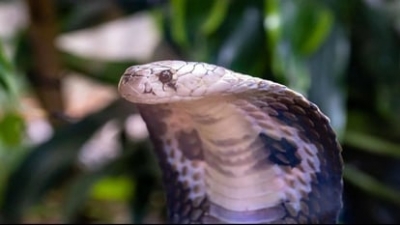
New Delhi, Feb 22 (IANS) A team of scientists at the Indian Institute of Science (IISc), Bengaluru and Scripps Research Institute, US, have developed a synthetic human antibody that can neutralise a potent neurotoxin produced by the Elapidae family of highly toxic snakes, which includes the cobra, king cobra, krait, and black mamba, found throughout Africa, Asia, and Australia.
The team adapted an approach used earlier to screen for antibodies against HIV and Covid-19 in order to synthesise the new venom-neutralising antibody.
“This is the first time that this particular strategy is being applied to develop antibodies for snakebite treatment,” said Senji Laxme R.R., doctoral student at Evolutionary Venomics Lab (EVL), IISC.
In the study published in the journal Science Translational Medicine, the researchers said that this development takes us one step closer to a universal antibody solution that can offer broad protection against a variety of snake venoms.
Snakebites cause thousands of deaths every year, especially in India and sub-Saharan Africa.
The current strategy for developing anti-venoms involves injecting snake venom into equines like horses, ponies, and mules, and collecting antibodies from their blood. But there are several problems.
“These animals get exposed to various bacteria and viruses during their lifetime,” said Kartik Sunagar, Associate Professor at the Centre for Ecological Sciences (CES), IISC.
“As a result, anti-venoms also include antibodies against microorganisms, which are therapeutically redundant. Research has shown that less than 10 per cent of a vial of antivenom actually contains antibodies that are targeted towards snake venom toxins.”
The antibody developed by the team targets a conserved region found in the core of a major toxin called the three-finger toxin (3FTx) in the elapid venom.
Although different species of elapids produce different 3FTxs, a handful of regions in the protein are similar.
The team zeroed in on one such conserved region – a disulphide core. They designed a large library of artificial antibodies from humans, which were displayed on yeast cell surfaces. They then tested the antibodies’ ability to bind to 3FTxs from various elapid snakes around the world.
After repeated screening, they narrowed down their choices to one antibody that could bind strongly to various 3FTxs.
Among the 149 variants of 3FTxs in public repositories, this antibody could bind to 99.
The researchers then tested their antibody in animal models. In one set of experiments, they pre-mixed the synthetic antibody with a toxic 3FTx produced by the Taiwanese banded krait, and injected it into mice.
Mice given just the toxin died within four hours. But those given the toxin-antibody mix survived past the 24-hour observation window and looked completely healthy.
The team also tested their antibody against the whole venom of the monocled cobra from eastern India and the black mamba from sub-Saharan Africa, and found similar results. The efficacy of the antibody was found to be nearly 15 times that of the conventional product.
Crucially, when they first injected the venom and then gave the antibody after a time delay – 0 minutes, 10 minutes, and 20 minutes – the antibody was still able to save mice.
The conventional product, however, only worked well when injected alongside the venom. A delay of even 10 minutes significantly reduced the potency of the conventional antivenom.
In addition, the team used cryo-EM to tease out the crystal structure of the toxin-antibody complex, and found that their binding was very similar to the binding between the toxin and receptors found in muscles and nerve cells.
The researchers used human-derived cell lines to produce the antibody, bypassing the need to inject the venom first into animals like horses.
“Because the antibody is fully human, we don’t expect any off-target or allergic responses,” Laxme added.
“This solves two problems at the same time,” said Sunagar. “First, it is an entirely human antibody and, hence, side-effects, including fatal anaphylaxis, occasionally observed in patients being treated with conventional antivenom, can be prevented. Secondly, this would mean that animals need not be harmed in future to produce this life-saving antidote.”
The same approach can be used to develop antibodies against other snake venoms too, which can then be combined into a single anti-venom therapy.
–IANS
rvt/vd
Disclaimer
The information contained in this website is for general information purposes only. The information is provided by TodayIndia.news and while we endeavour to keep the information up to date and correct, we make no representations or warranties of any kind, express or implied, about the completeness, accuracy, reliability, suitability or availability with respect to the website or the information, products, services, or related graphics contained on the website for any purpose. Any reliance you place on such information is therefore strictly at your own risk.
In no event will we be liable for any loss or damage including without limitation, indirect or consequential loss or damage, or any loss or damage whatsoever arising from loss of data or profits arising out of, or in connection with, the use of this website.
Through this website you are able to link to other websites which are not under the control of TodayIndia.news We have no control over the nature, content and availability of those sites. The inclusion of any links does not necessarily imply a recommendation or endorse the views expressed within them.
Every effort is made to keep the website up and running smoothly. However, TodayIndia.news takes no responsibility for, and will not be liable for, the website being temporarily unavailable due to technical issues beyond our control.
For any legal details or query please visit original source link given with news or click on Go to Source.
Our translation service aims to offer the most accurate translation possible and we rarely experience any issues with news post. However, as the translation is carried out by third part tool there is a possibility for error to cause the occasional inaccuracy. We therefore require you to accept this disclaimer before confirming any translation news with us.
If you are not willing to accept this disclaimer then we recommend reading news post in its original language.











